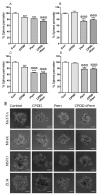In Vitro Characterization of Cisplatin and Pemetrexed Effects in Malignant Pleural Mesothelioma 3D Culture Phenotypes
- PMID: 31569615
- PMCID: PMC6826727
- DOI: 10.3390/cancers11101446
In Vitro Characterization of Cisplatin and Pemetrexed Effects in Malignant Pleural Mesothelioma 3D Culture Phenotypes
Abstract
Malignant pleural mesothelioma (MPM) is an aggressive cancer with poor prognosis. The main treatment for MPM is doublet chemotherapy with Cisplatin and Pemetrexed, while ongoing trials test the efficacy of pemetrexed monotherapy. However, there is lack of evidence regarding the effects of Cisplatin and Pemetrexed on MPM cell phenotypes, especially in three-dimensional (3D) cell cultures. In this study, we evaluated the effects Cisplatin and Pemetrexed on cell viability using homologous cell derived extracellular matrix (hECM) as substratum and subsequently in the following 3D cell culture phenotypes: tumor spheroid formation, tumor spheroid invasion, and collagen gel contraction. We used benign mesothelial MeT-5A cells as controls and the MPM cell lines M14K (epithelioid), MSTO (biphasic), and ZL34 (sarcomatoid). Cell viability of all cell lines was significantly decreased with all treatments. Mean tumor spheroid perimeter was reduced after treatment with Pemetrexed or the doublet therapy in all cell lines, while Cisplatin reduced the mean spheroid perimeter of MeT-5A and MSTO cells. Doublet treatment reduced the invasive capacity of spheroids of cell lines into collagenous matrices, while Cisplatin lowered the invasion of the MSTO and ZL34 cell lines, and Pemetrexed lowered the invasion of MeT-5A and ZL34 cell lines. Treatment with Pemetrexed or the combination significantly reduced the collagen gel contraction of all cell lines, while Cisplatin treatment affected only the MeT-5A and M14K cells. The results of the current study can be used as an in vitro 3D platform for testing novel drugs against MPM for ameliorating the effects of first line chemotherapeutics.
Keywords: 3D cultures; cisplatin; homologous cell derived extracellular matrix; malignant pleural mesothelioma; mesothelial cells; pemetrexed; pleura; tumor spheroid.
Conflict of interest statement
The authors declare no conflict of interest.
Figures




References
-
- Bakker E., Guazzelli A., Krstic-Demonacos M., Lisanti M., Sotgia F., Mutti L. Current and prospective pharmacotherapies for the treatment of pleural mesothelioma. Expert Opin. Orphan Drugs. 2017;5:455–465. doi: 10.1080/21678707.2017.1325358. - DOI
LinkOut - more resources
Full Text Sources
Miscellaneous

